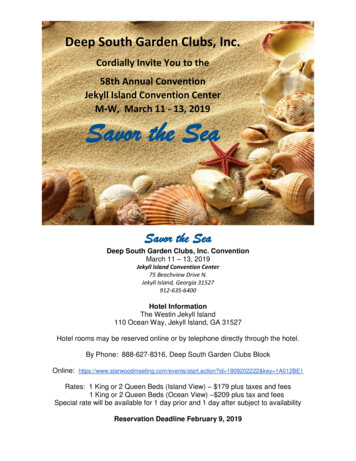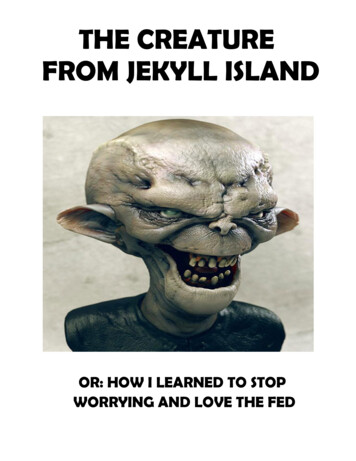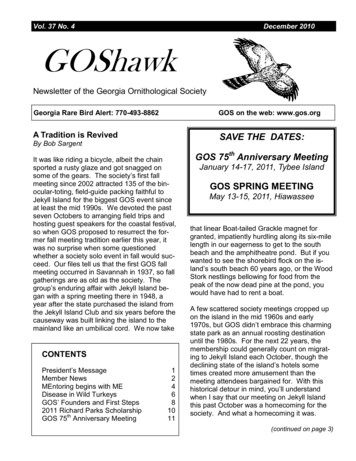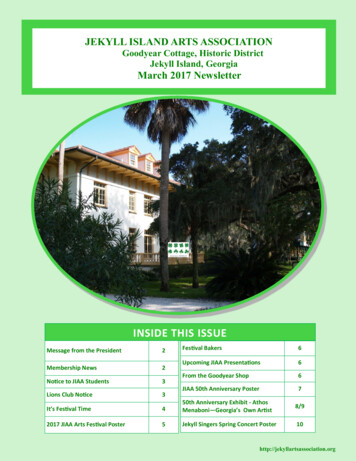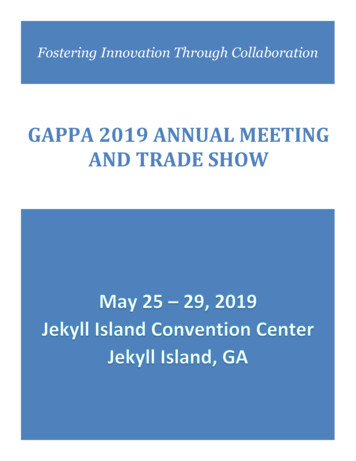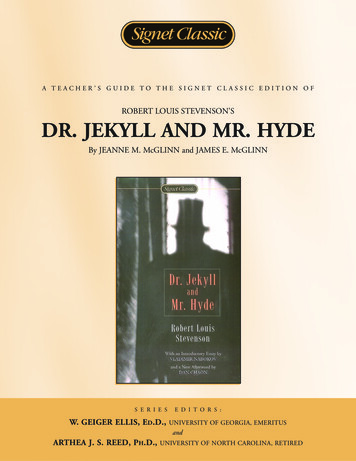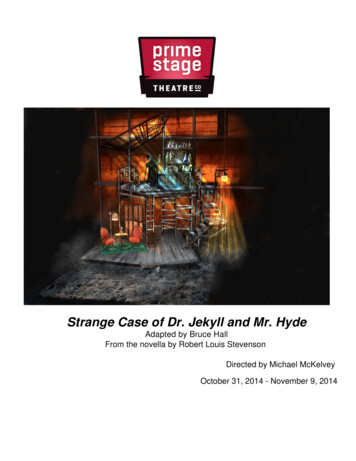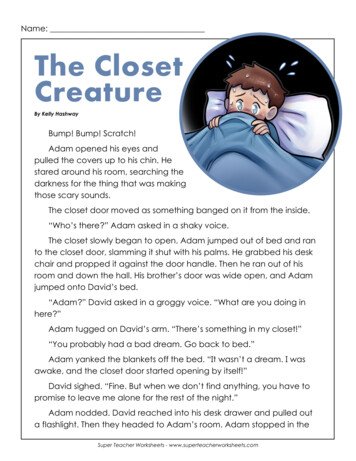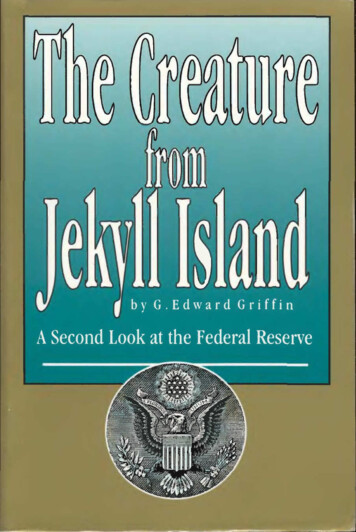
Transcription
Where does money come from? Where does it go? Whomakes it? The money magicians' secrets are unveiled. Here is aclose look at their mirrors and smoke machines, the pulleys,cogs, and wheels that create the grand illusion called money.A boring subject? Just wait' You'll be hooked in fiveminutes. Reads like a detective story - which it really is. But if sall true. This book is about the most blatant scam of history. If sall here: the cause of wars, boom-bust cycles, inflation, depression, prosperity. Your world view will definitely change.Putting it quite simply: this may be the most importantbook on world affairs you will ever read."A superb analysis deserving serious attention by allAmericans. Be prepared for one heck of a journey through timeand mind."Ron Paul, member of CongressHouse Banking Committee"What every American needs to know about central bankpower. A gripping adventure into the secret world of theinternational banking cartel."Mark Thornton, Asst. Professor of Economics,Auburn University; Coordinator Academic Affairs,Ludwig von Mises Institute"A magnificent accomplishment - a train-load of heavy history,organized so well and written in such a relaxed and easy stylethat it captivated me. I hated to put it d o w n . "Dan SmootPublisher/Editor, Dan Smoot Report"As a career banker and president of a bank consulting firm, Ithought I had a good understanding of the Federal Reserve. Butthis book changed the way I view our entire monetary system."Marilyn MacGruder Barn wallGrand Junction, Colorado
HOW TO READTHIS BOOKThick books can be intimidating. We tend to putoff reading them until we have a suitably largeblock of time—which is to say, often they arenever read. That is the reason a preview has beenplaced at the beginning and a summary at the endof each chapter. All of these together can be readin about one hour. Although they will not containdetails nor documentation, they will cover themajor points and will provide an overview of thecomplete story. The best way to read this book,therefore, is to begin with the previews of eachsection, followed by the chapter previews andsummaries. Even if the reader is not in a hurry,this is still an excellent approach. A look at themap before the journey makes it easier to grapplewith a topic such as this which spans so muchhistory.
THE CREATUREFROMJEKYLL ISLANDA Second Look at theFederal ReserveThird editionby G. Edward GriffinAmerican Media
Dedicated to the next generation-especially my own brood:James, Daniel, Ralph, and Kathleen.May this effort help to build for them a better world.Seventh printing: May 1998Sixth printing: September 1997Fifth printing: August 1996Fourth printing: September 1995Third printing: April 1995Second printing: November 1994First printing: July 1994Third edition: May 1998Second edition: September 1995First edition: July 1994 Copyright 1998,1995 and 1994 by G. Edward GriffinPublished by American MediaP.O. Box 4646Westlake Village, California 91359-1646Library of Congress Catalog Card Number: 98-71615ISBN 0-912986-21-2Manufactured in the United States
TABLE OF CONTENTSPrefaceAcknowledgmentsIntroductioniivvI. WHAT CREATURE IS THIS?1What is the Federal Reserve System? The answer maysurprise you. It is not federal and there are no reserves.Furthermore, the Federal Reserve Banks are not even banks. Thekey to this riddle is to be found, not at the beginning of the story,but in the middle. Since this is not a textbook, we are notconfined to a chronological structure. The subject matter is not acurriculum to be mastered but a mystery to be solved. So let usstart where the action is.1. The Journey to Jekyll Island2. The Name of the Game Is Bailout3. Protectors of the Public4. Home Sweet Loan5. Nearer to the Heart's Desire6. Building the New World Order325416785107II. A CRASH COURSE ON MONEY133The eight chapters contained in this and the followingsection deal with material that is organized by topic, notchronology. Several of them will jump ahead of events that arenot covered until later. Furthermore, the scope is such that thereader may wonder what, if any, is the connection with theFederal Reserve System. Please be patient. The importance willeventually become clear. It is the author's intent to coverconcepts and principles before looking at events. Without thisbackground, the history of the Federal Reserve is boring. With it,the story emerges as an exciting drama which profoundly affectsour lives today. So let us begin this adventure with a fewdiscoveries about the nature of money itself.7. The Barbaric Metal8. Fool's Gold9. The Secret Science10. The Mandrake Mechanism135155171185
III. THE NEW ALCHEMY215The ancient alchemists sought in vain to convert lead intogold. Modern alchemists have succeeded in that quest. The leadbullets of war have yielded an endless source of gold for thosemagicians who control the Mandrake Mechanism. The startlingfact emerges that, without the ability to create fiat money, mostmodern wars simply would not have occurred. As long as theMechanism is allowed to function, future wars are inevitable.This is the story of how that came to pass.11. The Rothschild Formula12. Sink theLusitania!13. Masquerade in Moscow14. The Best Enemy Money Can Buy217235263285IV. A TALE OF THREE BANKS307It has been said that those who are ignorant of history aredoomed to repeat its mistakes. It may come as a surprise to learnthat the Federal Reserve System is America's fourth centralbank, not its first. We have been through all this before and, eachtime, the result has been the same. Interested in what happened?Then let's set the coordinates of our time machine to the colonyof Massachusetts and the year 1690. To activate, turn to chapterfifteen.15. The Lost Treasure Map16. The Creature Comes to America17. A Den of Vipers18. Loaves and Fishes, and Civil War19. Greenbacks and Other Crimes309325341361377V. THE HARVEST405Monetary and political scientists continue to expound thetheoretical merits of the Federal Reserve System. It has become amodern act of faith that economic life simply could not go onwithout it. But the time for theory is past. The Creature movedinto its final lair in 1913 and has snorted and thrashed about thelandscape ever since. If we wish to know if it is a creature ofservice or a beast of prey, we merely have to look at what it hasdone. And, after the test of all those years, we can be sure thatwhat it has done, it will continue to do. Or, to use the Biblicalaxiom, a tree shall be known by the fruit it bears. Let us nowexamine the harvest.t
20. The London Connection21. Competition Is A Sin22. The Creature Swallows Congress23. The Great Duck Dinner407431451471VI. TIME TRAVEL INTO THE FUTURE505In the previous sections of this book, we have travelledthrough time. We began our journey by stepping into the past.As we crisscrossed the centuries, we observed wars, treachery,profiteering, and political deception. That has brought us to thepresent. Now we are prepared to ride our time machine into thefuture. It will be a hair-raising trip, and much of what lies aheadwill be unpleasant. But it has not yet come to pass. It is merelythe projection of present forces. If we do not like what we see,we still have an opportunity to change those forces. The futurewill be what we choose to make it.24. Doomsday Mechanisms25. A Pessimistic Scenario26. A Realistic ScenarioPHOTOGRAPHSThe seven men who met in secret at Jekyll IslandThe Fabian Society stained-glass windowFirst photo sectionPeriod cartoons about the RothschildsItems relating to the sinking of the LusitaniaSecond photo . Structure and Function of the Federal Reserve590B. Natural Laws of Human Behavior in Economics . 592C. Is Ml Subtractive or Accumulative?594BIBLIOGRAPHY596INDEX602
PREFACEDoes the world really need another book on the FederalReserve System?I have struggled with that question for several years. Myown library is mute testimony to the fact that there has been noshortage of writers willing to set off into the dark forest to dobattle with the evil dragon. But, for the most part, their bookshave been ignored by the mainstream, and the giant snorterremains undaunted in his lair. There seemed to be little reason tothink that I could succeed where so many others have failed.Yet, the idea was haunting. There was no doubt in my mindthat the Federal Reserve is one of the most dangerous creaturesever to stalk our land. Furthermore, as my probing brought meinto contact with more and more hard data, I came to realize thatI was investigating one of the greatest "who-dunits" of history.And, to make matters worse, I discovered who did it.Someone has to get this story through to the public. Theproblem, however, is that the public doesn't want to hear it. Afterall, this is bad news, and we certainly get enough of that as it is.Another obstacle to communication is that this tale truly isincredible, which means unbelievable. The magnitude by whichreality deviates from the accepted myth is so great that, for mostpeople, it simply is beyond credibility. Anyone carrying thismessage is immediately suspected of paranoia. Who will listento a madman?And, finally, there is the subject matter itself. It can becomepretty complex. Well, at least that's how it seems at first.Treatises on this topic often read like curriculum textbooks forbanking and finance. It is easy to become ensnared in a stickyweb of terminology and abstractions. Only monetary professionals are motivated to master the new language, and even theyoften find themselves in serious disagreement. For example, in arecent letter circulated by a group of monetary experts who, foryears, have conducted an ongoing exchange of ideas regardingmonetary reform, the editor said: "It is frustrating that wecannot find more agreement among ourselves on this vital issue.We seem to differ so much on definitions and on, really, an1
unbiased, frank, honest, correct understanding of just how ourcurrent monetary system does function."So why am I now making my own charge into the dragon'steeth? It's because I believe there is a definite change in the windof public attitude. As the gathering economic storm drawsnearer, more and more people will tune into the weatherreport—even if it is bad news. Furthermore, the evidence of thetruth of this story is now so overpowering that I trust my readerswill have no choice but to accept it, all questions of sanity aside.If the village idiot says the bell has fallen from the steeple andcomes dragging the bell behind him, well,.Lastly, I have discovered that this subject is not as complicated as it first appeared to be, and I am resolved to avoid thepitfall of trodding the usual convoluted path. What follows,therefore, will be the story of a crime, not a course on criminologyIt was intended that this book would be half its present sizeand be completed in about one year. From the beginning,however, it took on a life force of its own, and I became but aservant to its will. It refused to stay within the confinesprescribed and, like the genie released from its bottle, grew toenormous size. When the job was done and it was possible toassess the entire manuscript, I was surprised to realize that fourbooks had been written instead of one.First, there is a crash course on money, the basics of bankingand currency. Without that, it would be impossible to understand the fraud that now passes for acceptable practice withinthe banking system.Second, there is a book on how the world's central banks—the Federal Reserve being one of them—are catalysts for war.That is what puts real fire into the subject, because it shows thatwe are dealing, not with mere money, but with blood, humansuffering, and freedom itself.Third, there is a history of central banking in America. Thatis essential to a realization that the concept behind the FederalReserve was tried three times before in America. We need toknow that and especially need to know why those institutionswere eventually junked.Finally, there is an analysis of the Federal Reserve itself andits dismal record since 1913. This is probably the least importantpart of all, but it is the reason we are here. It is the leastimportant, not because the subject lacks significance, butii
because it has been written before by writers far more qualifiedand more skilled than I. As mentioned previously, however,those volumes generally have remained unread except bytechnical historians, and the Creature has continued to dineupon its hapless victims.There are seven discernible threads that are woven throughout the fabric of this study. They represent the reasons forabolition of the Federal Reserve System. When stated in theirpurest form, without embellishment or explanation, they soundabsurd to the casual observer. It is the purpose of this book,however, to show that these statements are all-too-easy tosubstantiate.The Federal Reserve System should be abolished for thefollowing reasons: It is incapable of accomplishing its stated objectives.(Chapter 1.) It is a cartel operating against the public interest. (Chapter 3.) It is the supreme instrument of usury. (Chapter 10.) It generates our most unfair tax. (Chapter 10.) It encourages war. (Chapter 14.) It destabilizes the economy. (Chapter 23.) It is an instrument of totalitarianism. (Chapters 5 and 26.)This is a story about limitless money and hidden globalpower. The good news is that it is as fascinating as any work offiction could be, and this, I trust, will add both pleasure andexcitement to the learning process.The bad news is that every detail of what follows is true.G. Edward Griffiniii
ACKNOWLEDGMENTSA writer who steals the work of another is called a plagiarist.One who takes from the works of many is called a researcher. Thatis a roundabout way of saying I am deeply indebted to the efforts ofso many who have previously grappled this topic. It is impossibleto acknowledge them except in footnote and bibliography. Withoutthe cumulative product of their efforts, it would have taken alifetime to pull together the material you are about to read.In addition to the historical facts, however, there are numerousconcepts which, to the best of my knowledge, are not to be found inprior literature. Primary among these are the formulation of certain"natural laws" which, it seemed to me, were too important to leaveburied beneath the factual data. You will easily recognize these andother editorial expressions as the singular product of my ownperceptions for which no one else can be held responsible.I would like to give special thanks to Myril Creer and Jim Toftfor having first invited me to give a lecture on this subject and, thus,forcing me to delve into it at some depth; and to Herb Joiner forencouraging me, after the speech, to "take it on the road." Thisbook is the end result of a seven-year journey that began with thosefirst steps. Wayne C. Rickert deserves a special medal for hisfinancial support to get the project started and for his incrediblepatience while it crawled toward completion. Thanks to Bill Jasperfor providing copies of numerous hard-to-locate documents.Thanks, also, to Linda Perlstein and Melinda Wiman for keepingmy business enterprises functioning during my preoccupation withthis project. And a very personal thanks to my wife, Patricia, forputting up with my periods of long absence while completing themanuscript, for meticulous proofreading, and for a most perceptivecritique of its development along the way.Finally, I would like to acknowledge those readers of the firstthree printings who have assisted in the refinement of this work.Because of their efforts most of the inevitable errata have beencorrected for the second edition. Even so, it would be foolhardy tothink that there are no more errors within the following pages. Ihave tried to be meticulous with even the smallest detail, but onecannot harvest such a huge crop without dropping a few seeds.Therefore, corrections and suggestions from new readers are sincerely invited. In my supreme optimism, I would like to think thatthey will be incorporated into future editions of this book.iv
INTRODUCTIONThe following exchange was published in the British humormagazine, Punch, on April 3, 1957. It is reprinted here as anappropriate introduction and as a mental exercise to limber themind for the material contained in this book.A. Yes, usually 500,000,000 orthereabouts. This is calledLiabilities.Q. What are banks for?A. To make money.Q. For the customers?Q. But if they've got it, how canthey be liable for it?A. For the banks.Q. Why doesn't bank advertising mention this?A. Because it isn't theirs.A. It would not be in good taste.But it is mentioned by implication in references to reserves of 249,000,000 or thereabouts.That is the money that they havemade.A. It has been lent to them bycustomers.Q. Then why do they have it?Q. You mean customers lendbanks money?A. In effect. They put moneyinto their accounts, so it is reallylent to the banks.Q. Out of the customers?A. I suppose so.Q. And what do the banks dowith it?Q. They also mention Assets of 500,000,000 or thereabouts.Have they made that too?A. Lend it to other customers.Q. But you said that money theylent to other people was Assets?A. Not exactly. That is themoney they use to make money.A. Yes.Q. I see. And they keep it in asafe somewhere?Q. Then Assets and Liabilitiesmust be the same thing?A. Not at all. They lend it tocustomers.A. You can't really say that.Q. But you've just said it. If I put 100 into my account the bank isliable to have to pay it back, soit's Liabilities. But they go andlend it to someone else, and he isliable to have to pay it back, soit's Assets. It's the same 100,isn't it?Q. Then they haven't got it?A. No.Q. Then how is it Assets?A. They maintain that it wouldbe if they got it back.Q. But they must have somemoney in a safe somewhere?A. Yes. But.v
Q. Then it cancels out. It means,doesn't it, that banks haven'treally any money at all?A. Theoretically.Q. Never mind theoretically.And if they haven't any money,where do they get theirReserves of 249,000,000 orthereabouts?A. They wouldn't like you todraw it out again.Q. Why not? If I keep it thereyou say it's a Liability. Wouldn'tthey be glad if I reduced theirLiabilities by removing it?A. No. Because if you remove itthey can't lend it to anyone else.Q. But if I wanted to remove itthey'd have to let me?A. I told you. That is the moneythey have made.Q. How?A. Certainly.Q. But suppose they've alreadylent it to another customer?A. Well, when they lend your 100 to someone they chargehim interest.A. Then they'll let you havesomeone else's money.Q. How much?Q. But suppose he wants his too. and they've let me have it?A. It depends on the Bank Rate.Say five and a-half per cent.That's their profit.A. You're being purposely obtuse.Q. Why isn't it my profit? Isn't itmy money?Q. I think I'm being acute. Whatif everyone wanted their moneyat once?A. It's the theory of bankingpractice that.A. It's the theory of bankingpractice that they never would.Q. When I lend them my 100why don't I charge them interest?Q. So what banks bank on is nothaving to meet their commitments?A. You do.Q. You don't say. How much?A. It depends on the Bank Rate.Say half a per cent.A. I wouldn't say that.Q. Naturally. Well, if there'snothing else you think you cantell me.?Q. Grasping of me, rather?A. But that's only if you're notgoing to draw the money outagain.A. Quite so. Now you can go offand open a banking account.Q. But of course, I'm going todraw it out again. If I hadn'twanted to draw it out again Icould have buried it in the garden, couldn't I?Q. Just one last question.A. Of course.Q. Wouldn't I do better to go offand open up a bank?vi
Section IWHAT CREATUREIS THIS?What is the Federal Reserve System? The answermay surprise you. It is not federal and there areno reserves. Furthermore, the Federal ReserveBanks are not even banks. The key to this riddle isto be found, not at the beginning of the story, butin the middle. Since this is not a textbook, we arenot confined to a chronological structure. Thesubject matter is not a curriculum to be masteredbut a mystery to be solved. So let us start wherethe action is.
Chapter OneTHE JOURNEY TOJEKYLL ISLANDThe secret meeting on Jekyll Island in Georgia atwhich the Federal Reserve was conceived; thebirth of a banking cartel to protect its membersfrom competition; the strategy of how to convinceCongress and the public that this cartel was anagency of the United States government.The New Jersey railway station was bitterly cold that night.Flurries of the year's first snow swirled around street lights.November wind rattled roof panels above the track shed and gavea long, mournful sound among the rafters.It was approaching ten P.M., and the station was nearly emptyexcept for a few passengers scurrying to board the last Southboundof the day. The rail equipment was typical for that year of 1910,mostly chair cars that converted into sleepers with cramped upperand lower berths. For those with limited funds, coach cars werecoupled to the front. They would take the brunt of the engine'snoise and smoke that, somehow, always managed to seep throughunseen cracks. A dining car was placed between the sections as asubtle barrier between the two classes of travelers. By today'sstandards, the environment was drab. Chairs and mattresses werehard. Surfaces were metal or scarred wood. Colors were dark greenand gray.In their hurry to board the train and escape the chill of thewind, few passengers noticed the activity at the far end of theplatform. At a gate seldom used at this hour of the night was aspectacular sight. Nudged against the end-rail bumper was a longcar that caused those few who saw it to stop and stare. Its gleamingblack paint was accented with polished brass hand rails, knobs,frames, and filigrees. The shades were drawn, but through the opendoor, one could see mahogany paneling, velvet drapes, plush
4armchairs, and a well stocked bar. Porters with white serving coatswere busying themselves with routine chores. And there was thedistinct aroma of expensive cigars. Other cars in the station borenumbers on each end to distinguish them from their dull brothers.But numbers were not needed for this beauty. On the center of eachside was a small plaque bearing but a single word: ALDRICH.The name of Nelson Aldrich, senator from Rhode Island, waswell known even in New Jersey. By 1910, he was one of the mostpowerful men in Washington, D.C., and his private railway caroften was seen at the New York and New Jersey rail terminalsduring frequent trips to Wall Street. Aldrich was far more than asenator. He was considered to be the political spokesman for bigbusiness. As an investment associate of J.P. Morgan, he hadextensive holdings in banking, manufacturing, and public utilities.His son-in-law was John D. Rockefeller, Jr. Sixty years later, hisgrandson, Nelson Aldrich Rockefeller, would become VicePresident of the United States.When Aldrich arrived at the station, there was no doubt he wasthe commander of the private car. Wearing a long, fur-collaredcoat, a silk top hat, and carrying a silver-tipped walking stick, hestrode briskly down the platform with his private secretary,Shelton, and a cluster of porters behind them hauling assortedtrunks and cases.No sooner had the Senator boarded his car when several morepassengers arrived with similar collections of luggage. The lastman appeared just moments before the final "aaall aboarrrd." Hewas carrying a shotgun case.While Aldrich was easily recognized by most of the travelerswho saw him stride through the station, the other faces were notfamiliar. These strangers had been instructed to arrive separately,to avoid reporters, and, should they meet inside the station, topretend they did not know each other. After boarding the train,they had been told to use first names only so as not to reveal eachother's identity. As a result of these precautions, not even theprivate-car porters and servants knew the names of these guests.Back at the main gate, there was a double blast from theengine's whistle. Suddenly, the gentle sensation of motion; theexcitement of a journey begun. But, no sooner had the train clearedthe platform when it shuttered to a stop. Then, to everyone'ssurprise, it reversed direction and began moving toward the station
THE JOURNEY TO JEKYLL ISLAND5again. Had they forgotten something? Was there a problem withthe engine?A sudden lurch and the slam of couplers gave the answer. Theyhad picked up another car at the end of the train. Possibly the mailcar? In an instant the forward motion was resumed, and allthoughts returned to the trip ahead and to the minimal comforts ofthe accommodations.And so, as the passengers drifted off to sleep that night to therhythmic clicking of steel wheels against rail, little did they dreamthat, riding in the car at the end of their train, were seven men whorepresented an estimated one-fourth of the total wealth of the entireworld.This was the roster of the Aldrich car that night:1. Nelson W. Aldrich, Republican "whip" in the Senate, Chairmanof the National Monetary Commission, business associate of J.P.Morgan, father-in-law to John D. Rockefeller, Jr.;2. Abraham Piatt Andrew, Assistant Secretary of the United StatesTreasury;3. Frank A. Vanderlip, president of the National City Bank of NewYork, the most powerful of the banks at that time, representingWilliam Rockefeller and the international investment bankinghouse of Kuhn, Loeb & Company;4. Henry P. Davison, senior partner of the J.P. Morgan Company;5. Charles D. Norton, president of J.P. Morgan's First National Bankof New York;16. Benjamin Strong, head of J.P. Morgan's Bankers Trust Company;and7. Paul M. Warburg, a partner in Kuhn, Loeb & Company, arepresentative of the Rothschild banking dynasty in Englandand France, and brother to Max Warburg who was head of theWarburg banking consortium in Germany and the Netherlands.1. In private correspondence between the author and Andrew L. Gray, the GrandNephew of Abraham P. Andrew, Mr. Gray claims that Strong was not inattendance. On the other hand, Frank Vanderlip—who was there—says in hismemoirs that he was. How could Vanderlip be wrong? Gray's response: "He wasin his late seventies when he wrote the book and the essay in question. Perhapsthe wish was father to the thought." If Vanderlip truly was in error, it was perhapsnot so significant after all because, as Gray admits: "Strong would have been amongthose few to be let in on the secret." In the absence of further confirmation to thecontrary, we are compelled to accept Vanderlip's account.
6THE CREATURE FROM JEKYLL ISLANDCONCENTRATION OF WEALTHCentralization of control over financial resources was faradvanced by 1910. In the United States, there were two main focalpoints of this control: the Morgan group and the Rockefeller group.Within each orbit was a maze of commercial banks, acceptancebanks, and investment firms. In Europe, the same process hadproceeded even further and had coalesced into the Rothschildgroup and the Warburg group. An article appeared in the Nezv YorkTimes on May 3, 1931, commenting on the death of George Baker,one of Morgan's closest associates. It said: "One-sixth of the totalwealth of the world was represented by members of the JekyllIsland Club." The reference was only to those in the Morgan group,(members of the Jekyll Island Club). It did not include theRockefeller group or the European financiers. When all of these arecombined, the previous estimate that one-fourth of the world'swealth was represented by these groups is probably conservative.In 1913, the year that the Federal Reserve Act became law, asubcommittee of the House Committee on Currency and Banking,under the chairmanship of Arsene Pujo of Louisiana, completed itsinvestigation into the concentration of financial power in theUnited States. Pujo was considered to be a spokesman for the oilinterests, part of the very group under investigation, and dideverything possible to sabotage the hearings. In spite of his efforts,however, the final report of the committee at large was devastating:Your committee is satisfied from the proofs submitted . thatthere is an established and well defined identity and community ofinterest between a few leaders of finance . which has resulted in greatand rapidly growing concentration of the control of money and creditin the hands of these few men.Under our system of issuing and distributing corporate securitiesthe investing public does not buy directly from the corporation. Thesecurities travel from the issuing house through middlemen to theinvestor. It is only the great banks or bankers with access to themainsprings of the concentrated resources made up of other people'smoney, in the banks, trust companies, and life insurance companies,and with control of the machinery for creating markets anddistributing securities, who have had the power to underwrite orguarantee the sale of large-scale security issues. The men who throughtheir control over the funds of our railroad and industrial companiesare able to direct where such funds shall be kept, and thus to createthese great reservoirs of the people's money are the ones who are in a
THE JOURNEY TO JEKYLL ISLAND7position to tap those reservoirs for the ventures in which they areinterested and to prevent their being tapped for purposes which theydo not approve.When we consider, also, in this connection that into thesereservoirs of money and credit there flow a large part of the reserves ofthe banks of the country, that they are also the agents andcorrespondents of the out-of-town banks in the loaning of theirsurplus funds in the only public money market of the country, andthat a small group of men and their partners and associates have nowfur
1. The Journey to Jekyll Island 3 2. The Name of the Game Is Bailou 2t 5 3. Protectors of the Public 41 4. Home Sweet Loan 67 5. Nearer to the Heart's Desire 85 6. Building the New World Order 107 II. A CRASH COURS OE N MONE 13Y 3 The eigh chaptert containes in thid ans thd followine g section dea witl materiah tha ilts organize by topicd no,t
